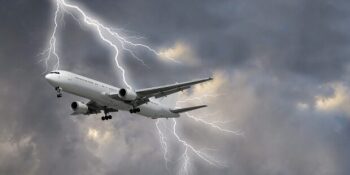There’s a good chance you’ve been on an aircraft struck by lightning. After all, lightning will strike planes 1-4 times annually. Maybe you saw a flash, or perhaps you heard loud noises. Or maybe you felt and saw nothing at all. Rest assured, though, that nothing serious should happen when lightning strikes a plane because of how well-engineered aircraft are to deal with strikes. Let’s dive into what exactly happens.

To begin with, aircraft bodies are heavily conductive and ionize quickly. When there is a significant increase in the electromagnetic field density, commonly observed in thunderstorms, ionization occurs. In particular, the ionization occurs on the edges of the fuselage, like the cockpit or wingtips, which tend to be sharper. The ionization may extend off the tips, trying to attract the energy found in the charged clouds in the thunderstorm.
Lightning occurs when the charged ionized air emanating off of the aircraft joins with charged, ionized air in the cloud. Most often, the plane is trapped in between the strike. At this point, lightning currents travel along the aircraft and exit to the ground or back into the sky. Normally, the current leaves at another extremity, such as the tail. Aircraft are also at a high risk of being caught in a strike at airports. They are equally likely to ionize and pose a major threat to individuals on the ground working near the aircraft.

Because aircraft bodies are very conductive, passengers have little to fear. The current simply does not leave the body and enter more critical areas. According to Boeing, the metal surface on most of their non-composite, older aircraft is sufficient to protect the airplane’s internal spaces from a lightning strike. The metal body also prevents electromagnetic energy from entering the aircraft’s electrical circuit. Essentially, it acts as a Faraday Cage that prevents electromagnetic currents from being altered significantly.
Most electrical components are unharmed for non-significant strikes, although they require maintenance and careful observation from engineers. For significant strikes, the electromagnetic energy may overpower the metal protection and minimally damage electrical components. In this case, flights with the aircraft tend to face extensive delays.

It follows that airlines and aircraft manufacturers take lightning protection very seriously. Nearly every airline has a lightning engineer to ensure that following every lightning strike, the fuselage, and electrical components are unharmed and well-protected to remain operational after the next strike. The last lightning-induced commercial aircraft crash was in 1967—a testament to the engineering brilliance of modern-day aircraft.
Comments (0)
Add Your Comment
SHARE
TAGS
INFORMATIONAL Lightning Engineering Safety Weather ClimateRECENTLY PUBLISHED
 Learjet Owned By Vince Neil Crashes Into Gulfstream Jet, 1 Fatality Confirmed
On February 10th, around 14:30 local time, a Learjet private jet aircraft crashed into another private jet after landing at Scottsdale Airport (SCF) in Arizona.
NEWS
READ MORE »
Learjet Owned By Vince Neil Crashes Into Gulfstream Jet, 1 Fatality Confirmed
On February 10th, around 14:30 local time, a Learjet private jet aircraft crashed into another private jet after landing at Scottsdale Airport (SCF) in Arizona.
NEWS
READ MORE »
 Seattle Plane Strike 2025: Japan Airlines and Delta Collision Raises Safety Concerns
Seattle-Tacoma International Airport saw a concerning incident on Wednesday morning when a Japan Airlines (JAL) plane clipped a parked Delta Air Lines jet while taxiing. Thankfully, no one was injured, but passengers described the collision as a frightening experience.
NEWS
READ MORE »
Seattle Plane Strike 2025: Japan Airlines and Delta Collision Raises Safety Concerns
Seattle-Tacoma International Airport saw a concerning incident on Wednesday morning when a Japan Airlines (JAL) plane clipped a parked Delta Air Lines jet while taxiing. Thankfully, no one was injured, but passengers described the collision as a frightening experience.
NEWS
READ MORE »
 Ethiopian Airlines Expands Cargo Fleet with New Boeing 777 Freighter
Ethiopian Airlines has expanded its cargo fleet with a brand-new Boeing 777 Freighter, registered as ET-BAB (MSN 68140). The aircraft was delivered directly from Boeing’s factory in Everett, Washington, USA, and landed at Addis Ababa Bole International Airport at 3:41 PM (GMT+3) on Wednesday, January 22, 2025.
NEWS
READ MORE »
Ethiopian Airlines Expands Cargo Fleet with New Boeing 777 Freighter
Ethiopian Airlines has expanded its cargo fleet with a brand-new Boeing 777 Freighter, registered as ET-BAB (MSN 68140). The aircraft was delivered directly from Boeing’s factory in Everett, Washington, USA, and landed at Addis Ababa Bole International Airport at 3:41 PM (GMT+3) on Wednesday, January 22, 2025.
NEWS
READ MORE »





